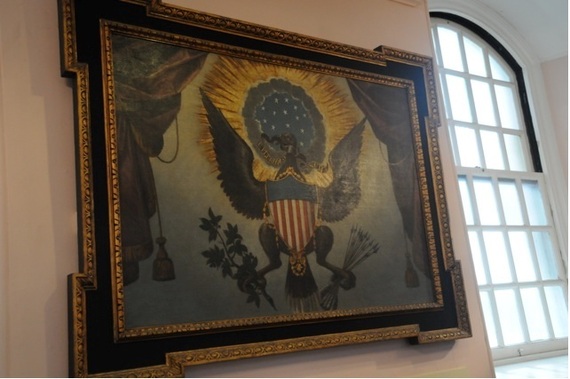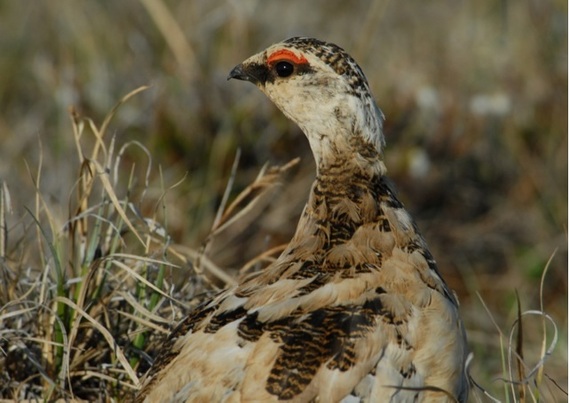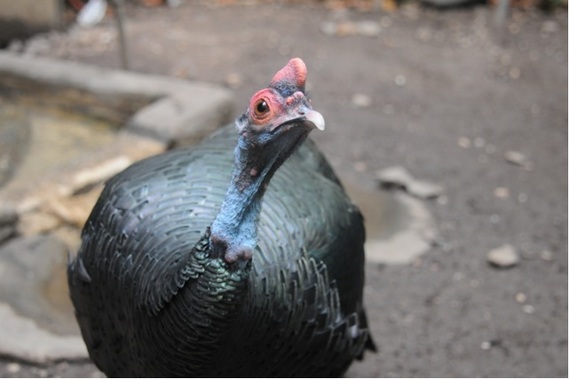"For the Truth," Ben Franklin wrote to his daughter in 1784, "the Turkey is in Comparison a much more respectable Bird, and withal a true original Native of America... He is besides, though a little vain & silly, a Bird of Courage."
Thus Franklin expressed his lonely support for the turkey as our national symbol over the bald eagle, a species he perceived as lazy and of "bad moral character." But Washington, Adams, and others prevailed, and the lazy bald eagle endures as our National Symbol. It should be noted for the record that a 1786 painting of our symbol now hanging in St. Paul's Chapel, New York City, over Washington's pew, looks vaguely turkey-like in an eagle pose.

This wonderfully ambiguous early painting of our National Symbol (1786) hangs in St. Paul's Chapel in New York City. It seems a fowl version of an eagle. Photo credit: ©Steve Zack/WCS
Franklin was quite correct about the originality of the turkey to our New World. In fact turkeys are the only bird group indigenous to North America (bald eagles belong to a worldwide group of fishing eagles). We have two species: our wild turkey, originally from the southwest and eastern forests of the United States, and the ocellated turkey from the Yucatán Peninsula of Mexico. The wild turkey is the only fowl from the Americas to be domesticated (1,000 years ago in our Southwest).
Turkeys have, of course, come to symbolize our Thanksgiving feast, both in the U.S. and in Canada. As we give thanks this season, I think it appropriate we better appreciate the meal on our plate as a remarkable species of often striking appearance in the wild. Specifically, I want to address the "vain and silly" aspect Franklin was referring to -- that of the Wild Turkey "Tom," the displaying male.
Turkeys are both sexually dimorphic (males larger than females, more than double the weight) and sexually dichromatic (males much more colorful than the more cryptic females). All pheasants and near relatives are that way. Think of peacocks, jungle fowl, grouse, and ptarmigan -- showy males all.

Rock Ptarmigan in Arctic Alaska likewise display fleshy structures in the head. Photo credit: ©Steve Zack/WCS
Diversity within the whole pheasant family has an evolutionary history tied to both the show traits of males and a rigorous preference for such traits by females. Females alone do the incubation and rearing of young; the male partners they choose must exhibit distinctive physical features and abilities worthy of passing on (via genes) to offspring.
Thus sexual selection, not natural selection, is the greater driver of diversity in this family. The vanity and silliness of male turkeys and their relatives derive from an evolutionary legacy developing and maintaining a suite of characters and behaviors meant to attract females.
Consider the Tom Turkey. His unfeathered head is crowned by a skull cap, and the bare skin is marked by red out-pockets of skin called caruncles. A sac-like snood above the bill can be distended. The throat has a dewlap. The latter three features can all flush vivid red from hemoglobin. The body feathers are iridescent; particularly striking is the large, fan-shaped tail. Spurs on the leg put oomph in contests among males and grow with age.
Observations in nature and experiments with wild turkeys in captivity have revealed that females choose male partners with longer snoods and wider skullcaps. These traits, in turn, are negatively associated with parasite loads. Coccidian parasites are common among Wild Turkeys, and can reduce the color and vigor of displaying males.

Ocellated Turkeys, here from the World of Birds at the Bronx Zoo, are the close relative of our Wild Turkey. Photo credit: ©Steve Zack/WCS
Ongoing studies continue to provide details of mate choice, sexual selection, and diversity in bird species. Their color vision spreads further into the UV spectrum than ours and it seems likely that females are choosing yet more colors in their mates than we can perceive.
Similarly, the vigor in male displays is getting a more quantitative look. The female manakin (a songbird) chooses its mate on the basis of very subtle differences in display rates -- some on the order of tens of milliseconds imperceptible to the human eye. These choices seem to indicate that females are evaluating motor skill abilities that may, in turn, facilitate survival.
Perhaps it is only fitting, then, that on our national day of thanks, we humans might seem to take our own cues from these wild fowl. Here in Portland, my family will sit down with our tasty heritage turkey rubbed with juniper berries and other spices. My wife Shawne prefers it, and I need to work hard to present this "Bird of Courage" to my own discerning family.